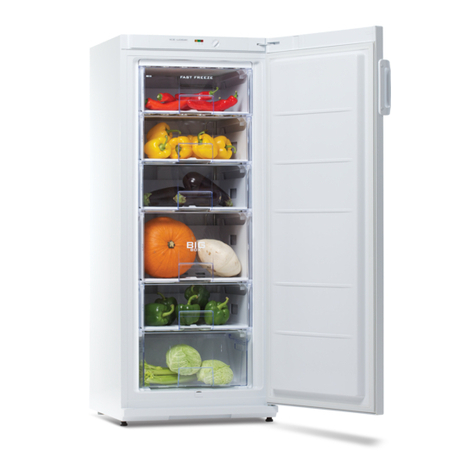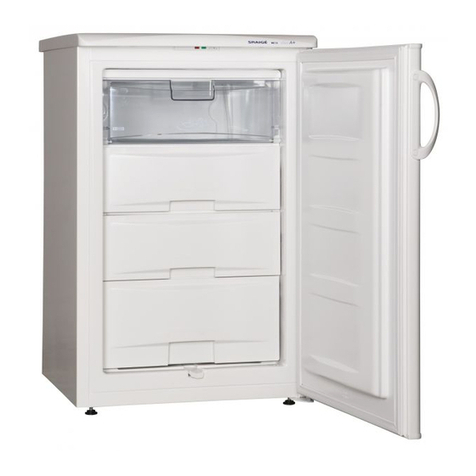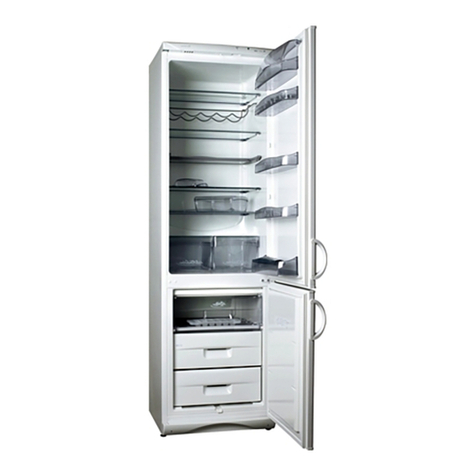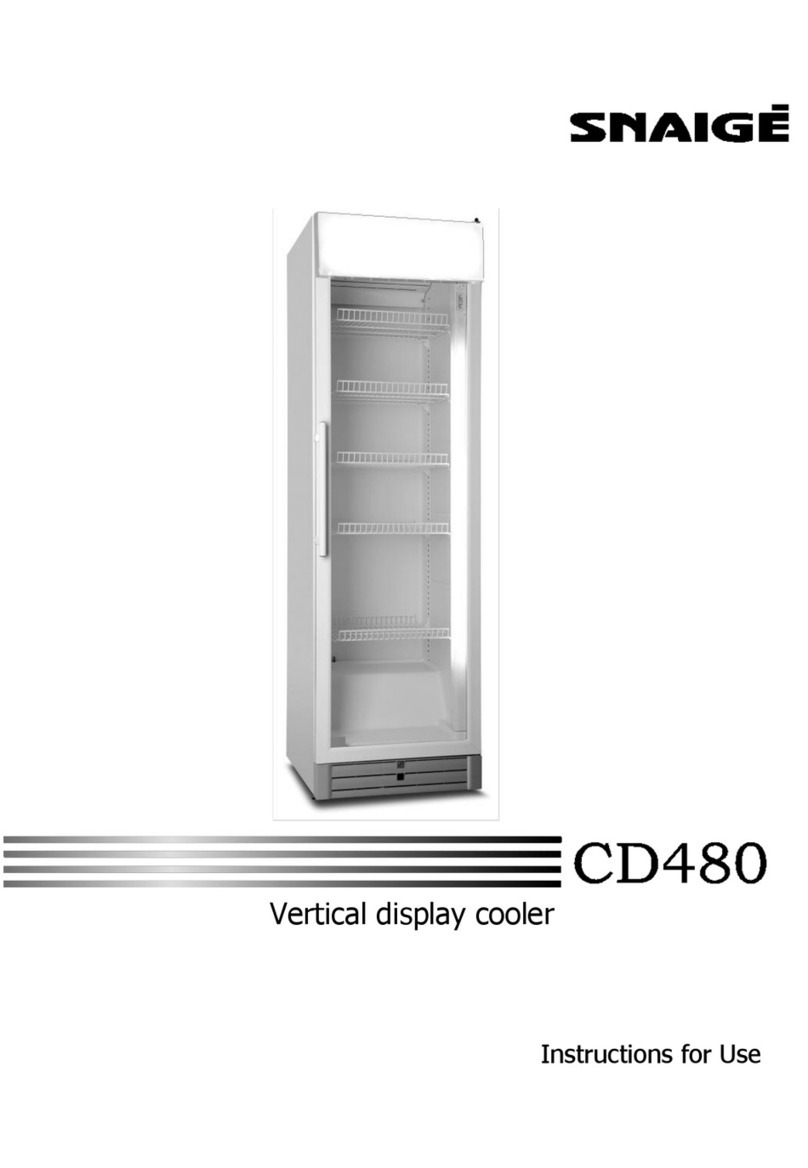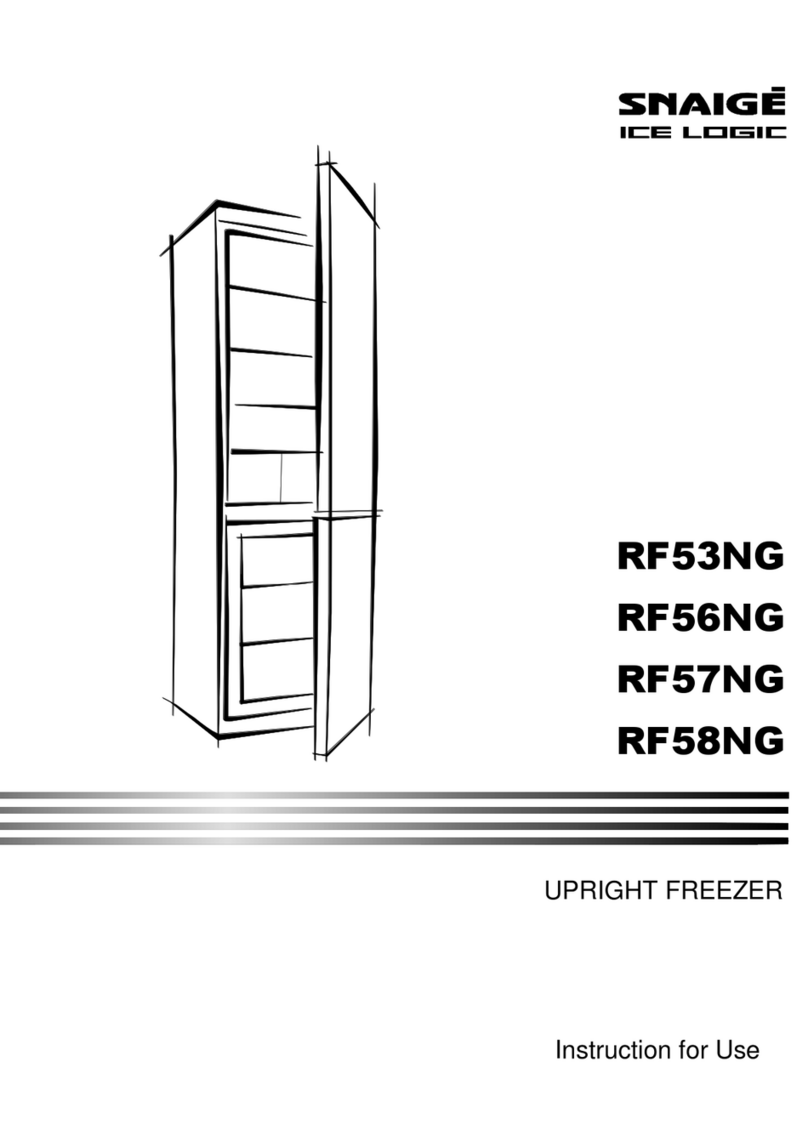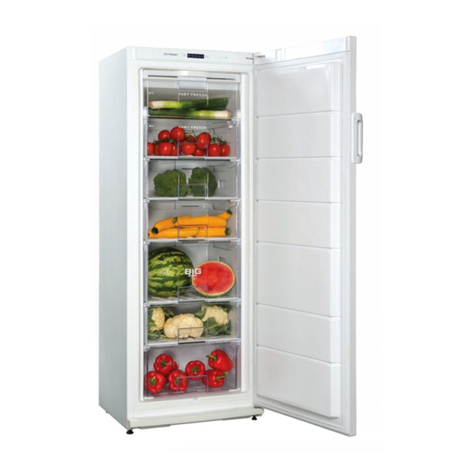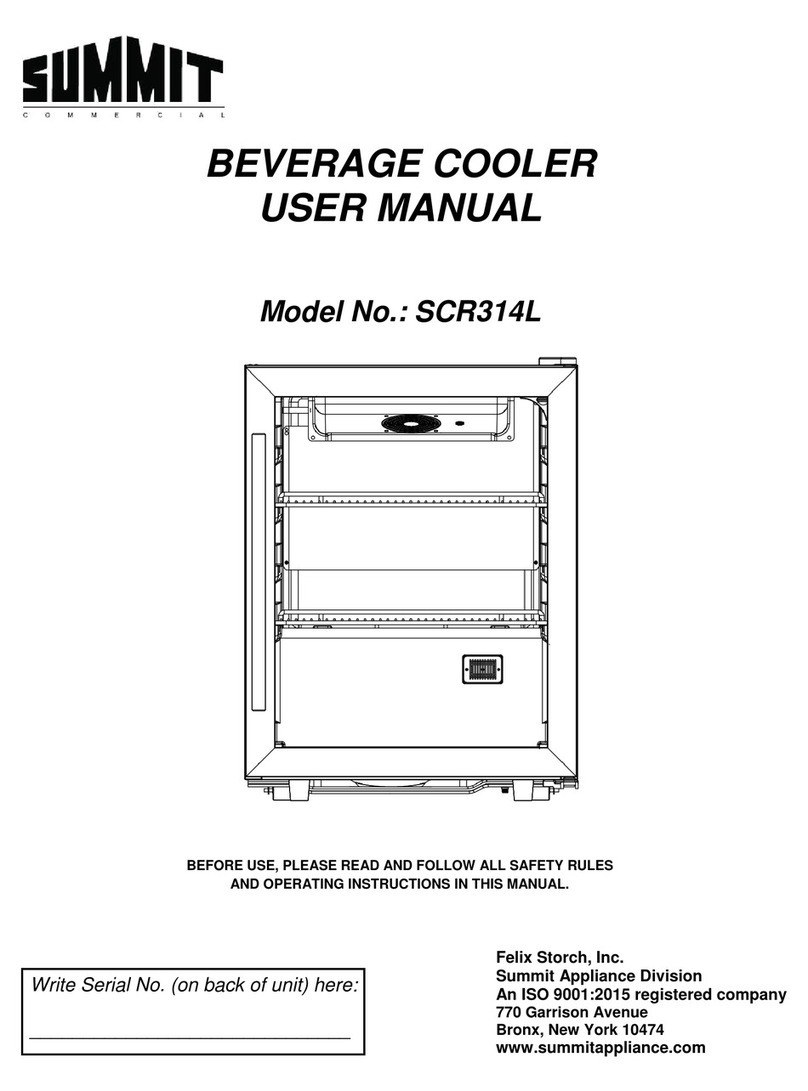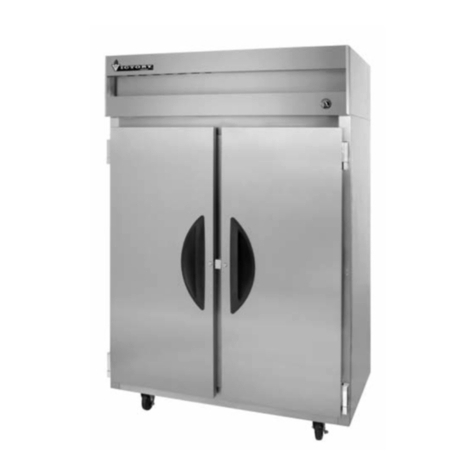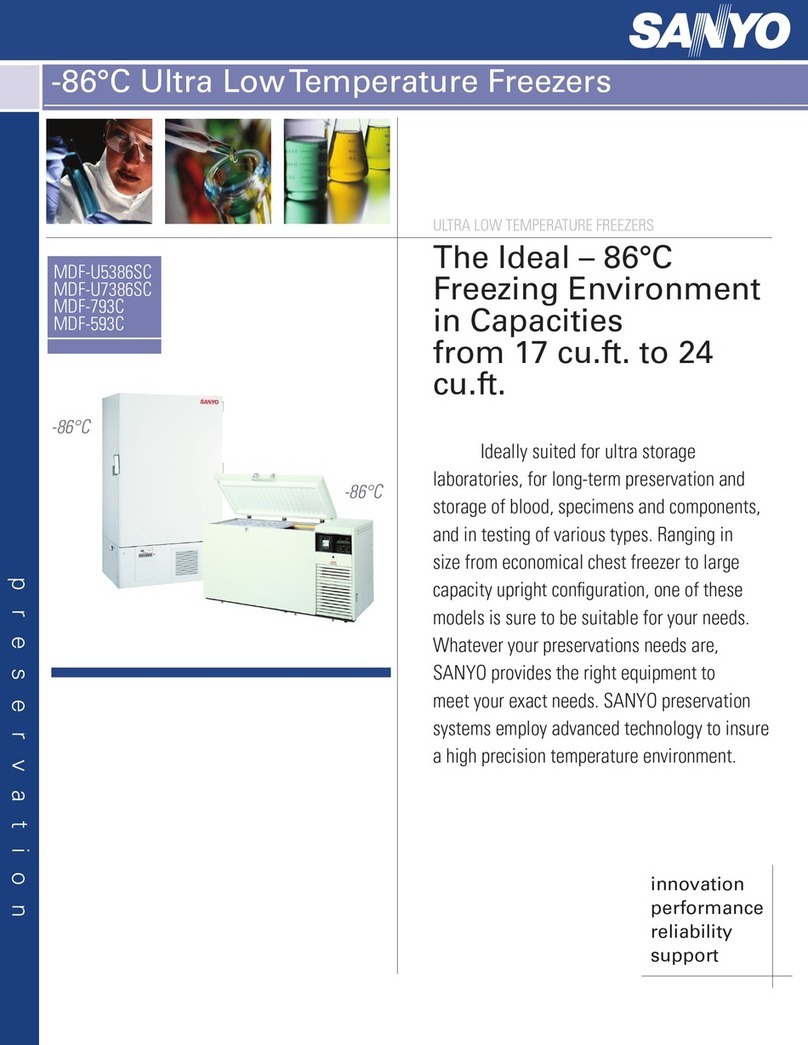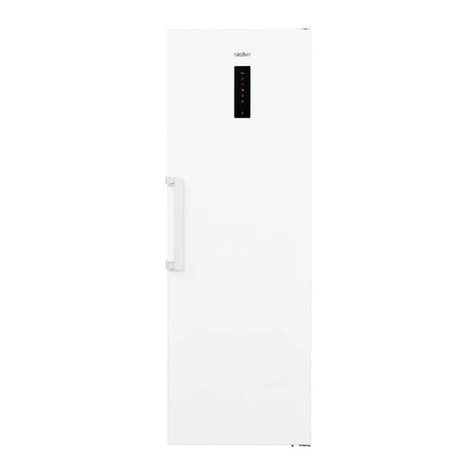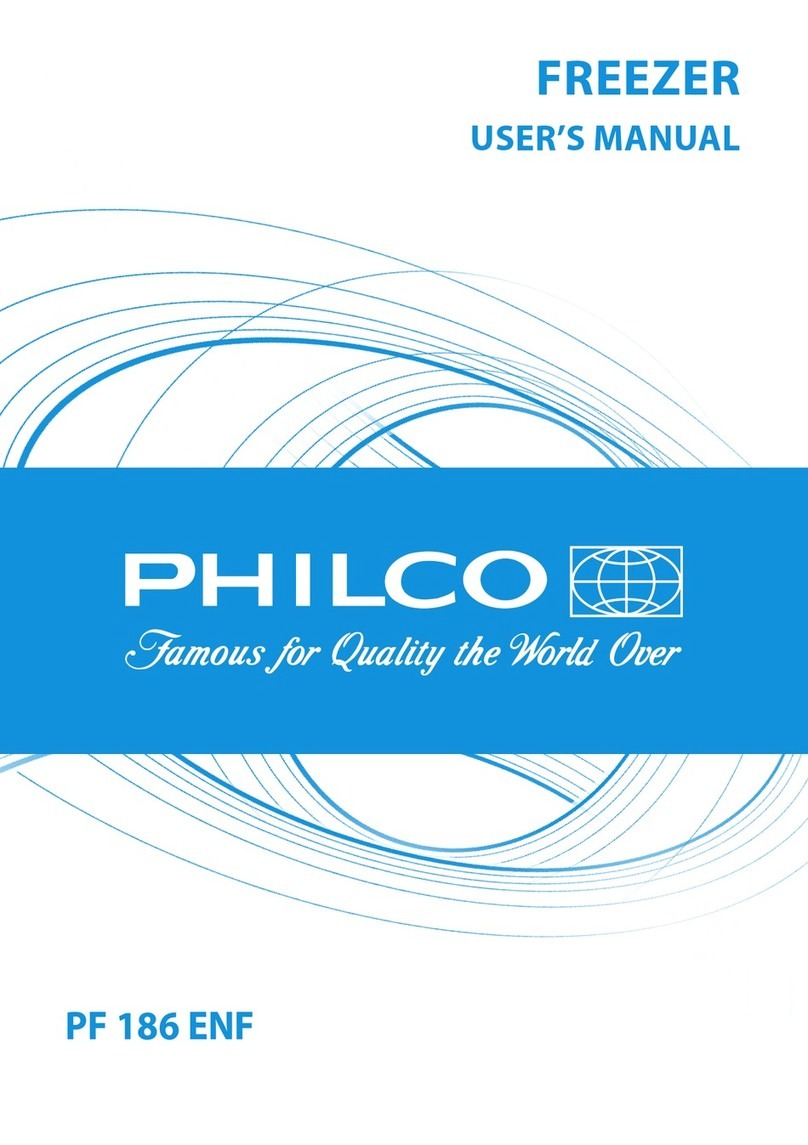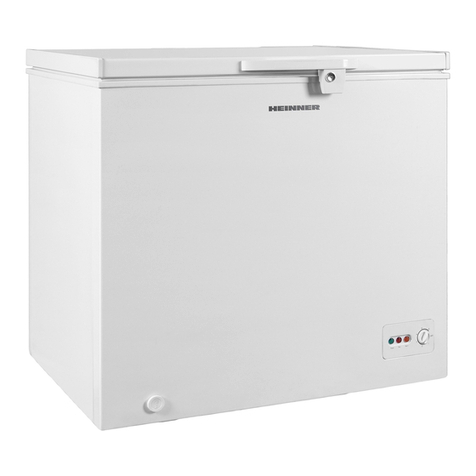SNAIGE F 27FG User manual

Instructions for Use Upright Freezer
F 27FG

1
SAFETY INSTRUCTIONS
CAREFULLY READ THE INSTRUCTION MANUAL. If instructions are not
followed, there is a risk of injury, damage of the appliance and loss of the right to
free warranty service. We recommend to keep the Instruction manual the whole
time you have the appliance. When you sell the appliance pass the Instruction
manual to the new owner of the appliance.
WARNING!
–Do not cover the ventilation holes at the top and on the sides of the
appliance.
–Do not use any mechanical means or electrical devices to hasten the thawing
process when cleaning the freezer compartment.
–Do not use electrical appliances inside the food storage compartments of the
appliance, unless they are of the type recommended by the manufacturer.
–If the supply cord is damaged it must be replaced by the manufacturer,
manufacturer service agent or a similarly qualified person, in order to avoid a
hazard.
–Disposal of the appliance should be according to national rules.
–Do not damage the appliance refrigeration system. It contains the refrigerant
gas R600a. If the refrigeration system is damaged:
Do not use any open flame.
Avoid sparks―do not turn on any electrical appliances or lighting
fixtures.
Immediately ventilate the room.
–Do not allow children to play with the appliance or to plug it in or unplug from
the electricity supply socket. Do not allow children to play with the packaging
material from the appliance.
–This appliance can be used by children aged from 8 years and above and
persons with reduced physical, sensory or mental capabilities or lack of
experience and knowledge if they have been given supervision or instruction
concerning use of the appliance in a safe way and understand the hazards
involved.
–Cleaning and user maintenance shall not be made by children without
supervision.
–The appliance should be used only for freezing foodstuffs.
–This appliance is not designed for the storage of explosive substances such

2
as aerosol cans with a flammable propellant.
–It is prohibited to store petrol and other flammable liquids near the appliance.
CONNECTION TO THE MAINS
–The appliance should only be connected to an earthed socket installed in
accordance with the regulations. Make sure that the supply voltage
corresponds with the voltage marked on the rating label. This product
complies with all binding CE labelling directives.. The earthed electrical
socket by which the appliance is connected to the mains should be in an
accessible place.
–IF THE APPLIANCE IS PRODUCED WITH THE SPECIAL SUPPLY CORD
IT CAN BE EXCHANGED ONLY BY THE SAME SPECIAL SUPPLY CORD
PROVIDED BY THE MANUFACTURER.
–TO AVOID HAZARDS, DAMAGED POWER SUPPLY CORDS SHOULD
ONLY BE REPLACED BY THE MANUFACTURER, A MAINTENANCE
TECHNICIAN OR A PERSON WITH AN EQUIVALENT QUALIFICATION.
–DO NOT USE extension cords or connectors (adapters), or hubs.
–When positioning the appliance, be careful that the electrical cord isn’t
squeezed in order to avoid its damage. Do not store heavy objects such as
cooling devices, furniture or other domestic devices next the appliance in
such a way that they could squeeze and damage the electrical cord. This can
cause a short circuit and a fire.
–Make sure that the plug of the electrical cord is not squeezed by the back
wall of the appliance or otherwise damaged. A damaged plug can be the
cause of a fire!
If the appliance is unplugged (for cleaning, moving to another place, etc.), it may be
repeatedly switched ON AFTER 15 MIN.
It is forbidden to use a technically damaged appliance.
The appliance can’t be disposed of by burning.
Do not place any switched on electrical devices (such as microwave ovens, hair
dryers, irons, electric kettles or other electrical devices) on top of the appliance
because this may cause ignition of plastic parts.
Do not place any dishes with liquids on top of the appliance and do not keep flowers
in vases or other liquid-filled vessels on the appliance.
Do not climb on or sit on the appliance, do not lean on or hang on the appliance doors
and do not allow children to do this.

3
IF THE APPLIANCE IS OUT OF ORDER AND IT IS NOT POSSIBLE TO
REPAIR IT BY MEANS OF GIVEN RECOMMENDATIONS, UNPLUG IT,
OPEN THE DOORS AND CALL THE SERVICE EXPERT. ONLY A
SERVICE REPRESENTATIVE CAN REMEDY ALL TECHNICAL OR
CONSTRUCTION FAULTS.
ENVIRONMENTAL PROTECTION INFORMATION
This symbol indicates that once the appliance is no longer needed, it cannot
be disposed together with other miscellaneous municipal waste. It should be
collected and eliminated separately, i.e. in containers specially marked with
this symbol in large-dimension rubbish collection areas. Full information on
where to submit the old appliance safety can be obtained from local
government authorities, the shop where you bought the appliance or the
manufacturer’s representatives.
If you decided to scrap the appliance, make it impossible to use in order to prevent
possible misadventure. Pull out the electric plug from the electricity supply socket and
then cut off the cord. Tear off the gasket. Break the door lock if any.
Do not dismantle the appliance yourself. Pass it on to recycling companies.
GENERAL INFORMATION
The appliance is a upright freezer. There is a frost-free freezing system (No Frost).
The freezer is intended for freezing and long-term storage of foodstuffs.
THE APPLIANCE IS ECOLOGICALLY CLEAN, CONTAINING NO MATERIALS HARMFUL TO
THE OZONE LAYER: the refrigerant used is R600a, the foaming agent used for the
appliance insulation is cyclopentane C5H10.
THE MANUFACTURER GUARANTEES RELIABLE OPERATION OF THE FREEZER WHEN
THE RELATIVE AIR HUMIDITY NOT GREATER THAN 70 PER CENT AND THE AMBIENT
TEMPERATURE IS:
+16 TO +32 DEGREES CELSIUS (Climate class N);
+16 TO +38 DEGREES CELSIUS (Climate class ST);
+16 TO +43 DEGREES CELSIUS (Climate class T).

4
Product data sheet
MANUFACTURER DATA. The manufacturer reserves the right ti make future changes to technical
parameters and specifications. Product is subject to changes and improvements.
¹)
1 = Refrigerator with one or more fresh-food storage compartments,
2 = Refrigerator-cellar, Cellar and Wine storage appliances,
3 = Refrigerator-chiller and Refrigerator with a 0-star compartment,
4 = Refrigerator with a one-star compartment, 5 = Refrigerator with a two-star compartment,
6 = Refrigerator with a three-star compartment, 7 = Refrigerator-freezer,
8 = Upright freezer, 9 = Chest freezer, 10 = Multi-use and other refrigerating appliances
²)
A+++ (most efficient) to D (least efficient)
³)
Annual energy consumption (AE C ) in kWh per year, based on standard test results for 24 hours.
Actual energy consumption will depend on how the appliance is used and where it is located.
4)
1 One-star compartment with nominal temperature of -6°C
2 Two-star compartment with nominal temperature of -12°C
3 Three-star compartment with nominal temperature of -18°C
4 Food freezer compartment (four-star compartment) with nominal temperature of -18°C
⁵)
Climate class: This appliance is intended to be used at an ambient temperature between lowest and
highest temperature: SN = 10°C-32°C, N = 16°C-32°C, ST = 16°C-38°C, T = 16°C-43°C
Modell
F 27FG
Category
Freezer
Energy efficiency class
A+
Annual energy consumption, kWh/annum
266
Actual consumption will depend on how the appliance is used and where it is located
Freezer net volume, L
201
Frost-free
yes
Temperature rise time
18
Freezing capacity, kg / 24 h
15
Climate class
N-T
Dimensions (H / W / D), cm
163 / 60 / 65
Noise level, dB(A) re1pW
41
Electrical Data
see in the product label

5
DESCRIPTION OF THE APPLIANCE, BASIC PARTS (fig. 1)
PREPARING THE APPLIANCE FOR OPERATION
It is recommended to prepare the appliance for operation with a helper.
•Remove package. Lift the appliance away from foamed polystyrene base - to not
raise and push it taking by handles or door.
•When positioning the appliance in chosen location, it will move more easily into
position if you lift the front a little and incline it backward, allowing it to roll on its
casters.
•Tear away the adhesive tapes –they are intended only for the transport of the
appliance. Remove the separate polystyrene part (transport protection) between the
rear of the device and condenser –metal grid (if available).
When you open the freezer compartment door a little red packing detail will fall out –
IT IS FOR TRANSPORTATION PURPOSES ONLY.
1
Control panel
4
Glass shelf
2
FAST FREEZE sections
5
Condenser
3
Frozen products sections
6
Compressor

6
•Take two supports 1from the bag and insert
them into the guides 2at the top back part of the
appliance (see picture).
•If the appliance is brought in from the cold
(temperature is not higher than +12 °C), you
should wait for two hours before connecting it to the mains.
The appliance should not be connected to the mains until all packing and
transport materials aren’t removed. Suitably dispose the packaging material
POSITIONING
•Place the appliance in a dry, well ventilated room.
WARNING! The appliance should not be operated in an unheated room
or porch. Place the appliance away from heat sources such as kitchen
stove/oven, radiators, or direct sunlight.
WARNING! The appliance must not touch any pipes for heating, gas or
water supply, or any other electrical devices.
•Do not cover the ventilation holes at the top of the
appliances–it must be a good air circulation around the
appliance. There should be a gap of at least 10 cm between
the top of the appliance body and any furniture that may be
above it. If this requirement is not followed, the appliance
consumes more electrical energy and its compressor may
overheat.
•The appliance must stand on a level surface and must not
touch the wall. If necessary, regulate the height of the
appliance by adjusting the levelling feet: by turning them
clockwise –the front of the appliance rises, by turning them
counter clockwise –it comes down. If the appliance is tilted
slightly backward –the doors will close by themselves.
•If the appliance is
placed in a corner, a gap
of at least 235 mm must be left between the
appliance body and the wall so that the freezer
door can be opened enough to pull out the
frozen product drawer (see fig.).

7
REVIEW OF ELECTRONIC CONTROL
TEMPERATURE REGULATION
When connecting the appliance to the mains for the first time, the blue temperature
indicating segment lights up at -18 (factory temperature setting -18 °C, but you can
select the preferred temperature according to your needs).
1.Temperature adjustment button is marked with the °C symbol.
Temperature setting in the refrigerator compartment
Activate temperature button 1: tap and keep until the temperature indicating segment
starts to flash in blue (active). Then release button 1and tap repeatedly until the
required temperature segment is blue (activated). One tap changes the temperature by
one position.
The temperature setting operates in a circle: for example, the active segment is at -22,
and if you want to set -18 °C after activation you have to tap temperature button 1 3
times –until the temperature indicating segment at -18 turns blue.
Freezer compartment temperature is adjustable on a five-point scale:
-16 –highest temperature (lowest cooling).
-24 –lowest temperature (highest cooling).
NOTE. After power loss the appliance turns on automatically, saving the last user-set
temperature in the refrigerator compartment.
IF THE FREEZER COMPARTMENT DOOR IS OPEN MORE THAN 30 SECONDS an audible
warning signal sounds, and silencing when the door is closed.
IF THE ROOM IS COOL, THE REFRIGERATION EQUIPMENT COOLS LESS, SO
TEMPERATURE IN THE REFRIGERATOR CAN RISE. Use temperature setting button 1 to
select a lower temperature.
Cooling appliance on/off
SHUTDOWN. Tap and hold button 1until the three temperature indicative segments are
blue. CAUTION! Voltage remains turned off.
SWITCHING ON. Tap and hold button 1until the set temperature indication segment is
blue.
NOTE: after turning on the cooling appliance, the last temperature set by the user will
be saved.
2. Temperature indicator segments. The temperature set-point segment is
illuminated in blue (active), while the other temperature value segments are grey
(inactive).

8
3. The FAST FREEZE function is activated by tapping button 3 marked with the “S“
symbol. When the FAST FREEZE function is on, the white segment in the centre of the
button is on. The FAST FREEZE function automatically shuts off after 26 hours or when
a temperature below –18 °C is achieved.
FREEZING OF FOODSTUFFS
When freezing large quantities of fresh food, turn on the FAST FREEZE function 24
hours in advance –tap FAST FREEZE function button 3 marked with symbol “S“ (see
Fig. 3). The segment in the centre of the button will light. The FAST FREEZE function
automatically shuts off after 26 hours, or when a temperature below –18 °C is achieved.
The light goes out in the centre of the FAST FREEZE button. Place fresh food prepared
for freezing in one or two lines in the rapid freezing compartment marked with the
symbol After 24 hours, move the frozen food products from the FAST FREEZE
section into the storage section drawer(s) (see Fig. 1).
•DO NOT EXCEED THE MAXIMUM QUANTITY OF FROZEN PRODUCTS INDICATED IN
THE PRODUCT DATA SHEET.
•Leave a gap of not less than 2,5 cm between the foodstuffs being frozen and the
upper partition (see fig.).
•Do not place unwrapped foodstuffs in the freezer sections.
•Fresh food for freezing should not touch already frozen foodstuffs.
•Do not freeze foodstuffs that are warmer than the room temperature.
•Do not freeze liquid foodstuffs in glass vessels or bottles. Do not freeze
carbonated beverages.
•Strictly observe the frozen foodstuffs validity dates indicated by the manufacturer on
the their packaging.
•WE RECOMMEND THAT FROZEN FISH AND SAUSAGE SHOULD BE STORED IN THE
FREEZER COMPARTMENT NOT LONGER THAN 6 MONTHS; CHEESE, POULTRY, PORK,
LAMB –NOT MORE THAN 8 MONTHS; BEEF, FRUIT AND VEGETABLES –NOT LONGER
THAN 12 MONTHS.
DEFROSTING
THE FREEZER COMPARTMENT gets defrosted automatically: it operates a frost-free
cooling system (No Frost). However, according to how often the freezer door were
opened and closed, and to - how warm products were placed into the appliance, the
frost can accumulate on walls of freezer inner liner and drawers. It is normal. But the
thicker is the layer of frost, the higher is a power consumption. In case if No Frost
system had not managed to evaporate the excess moisture and the frost layer has
formed on, you should defrost the appliance. To defrost the appliance, follow the steps
in sequence:
•WA RN ING! Turn the appliance off and pull the plug out of the electrical socket.
•Remove foodstuffs from freezer compartment. The frozen foodstuffs will not warm up
too much while you are thawing the freezer compartment if you cover them with a
thick cloth and keep them in a cool place.
•Leave door of freezer open. When the frost melts, clean and wipe dry the surfaces
and fixtures. Close the freezer door. Plug in and turn on the appliance.

9
CLEANING AND CARE
REGULARLY CLEAN THE APPLIANCE.
Remember that before defrosting the freezer compartment and
cleaning the back part of the appliance body you must disconnect the
appliance from the electrical energy supply socket by pulling the plug
out of the electricity outlet.
•Protect the appliance inner surfaces and plastic parts from fats, acids and sauces. In
case of accidental spills –immediately clean with warm soapy water or dishwashing
detergent. Wipe dry.
•Clean the appliance inner surfaces with warm soapy water. Dishwashing detergent
may also be used. Wipe dry inner and outer surfaces.
•Regularly clean the hermetic gaskets of the doors. Wipe dry.
•At least once a year clean dust away from the back part of the appliance body and the
compressor. A soft brush, electrostatic cloth or vacuum cleaner may be used for
cleaning.
•DO NOT use detergents containing abrasive particles, acid, alcohol or benzene for
cleaning the appliance inner and outer surfaces.
•DO NOT use for cleaning cloths or sponges that have coarse surfaces intended for
scrubbing.
PRACTICAL TIPS AND OBSERVATIONS
•Strictly observe the foodstuff validity time indicated by the manufacturer on the
product packaging.
•Do not consume ice made in the freezer straight away.
•Products will freeze more quickly if they are divided up and packed in small portions.
•IF THE APPLIANCE IS TO BE LEFT SWITCHED OFF FOR AN EXTENDED PERIOD,
LEAVE ITS DOORS OPEN.
Remarks on the appliance operating noise. As the appliance operates and
goes through the freezing cycle, various noises will be emitted. This is normal
and is not a sign of any malfunction.
•As the refrigerant circulates around the refrigeration system, it causes sounds like
murmuring, bubbling or rustling. Louder sounds like popping or clicking may be heard
for a short time as the freezer compressor switches on.
CHANGING THE OPENING DIRECTION OF THE DOORS
If you have decided to change the opening direction of the refrigerator door, we
recommend doing this with an assistant. You will need: spanners No 8 and No 10, a
screwdriver.
When changing the opening direction of the door, DO NOT lay the appliance down
horizontally!
Follow these steps:
1. Turn off the appliance and pull the plug out of the electricity supply
socket.

10
2. Remove the covers c from the body of the refrigerator and of the inner side of the
door. Also remove the upper bracket 6together with the nut and washers and the
spacer under the bracket.
3. Remove the door of the freezer compartment.
4. Remove the bottom cover 1.
5. Remove the bottom bracket 2together with washers on the axle and the plastic
spacer. Unscrew the axle together with washers from the bracket and screw them
into the aperture on the opposite side of the bracket symmetrically to former
position.
6. Remove the bottom bracket 7and fix the bottom bracket 2together with washers
on the axle and the plastic spacer instead of it. Screw the bracket 7in place of the
bracket 2.
7. Hang the freezer compartment door on the axle of bracket 7.
8. Turn the bracket 6around by 180° together with the washers on the axle and the
plastic spacer. Unsrew the axle and the washers and screw them on the other side
of the bracket. Once the bracket 6 is attached to the freezer compartmentdoor, fix it
in place on the other side of the freezer in the uppermost apertures.
9. Use the covers cto cover the bracket and the remaining space.
10. Remove the bolt covers aand the stoppers b. Remove the screws that hold the
handles in place. Move the handles to the other side and screw them in place. Place
the stoppers into the remaining apertures in the door, and put the screw caps in
place.
11. Remove the cover 10 from the bottom cover 1and insert it to the guides on the
other side of the bottom cover (symmetrically to former position). Insert left and
right legs of the bottom cover 1(see pic.) and push it until cover fixing.

11
OPERATION PROBLEMS AND THEIR SOLUTIONS
(TROUBLESHOOTING). What if …
•The appliance is plugged in to the mains but it does not work and the
electricity supply voltage indicator is not illuminated. Check that your house
electricity supply installations are in order. Check that the plug is correctly inserted
into the electricity supply socket.
•Temperature segment in centre of button is red. Cooling device is operating in
emergency mode. Contact the refrigeration appliance’s maintenance and repair
company without delay.
•Temperature cannot be set, FAST FREEZE function cannot be activated. Close
the refrigerator door, turn off the cooling device –disconnect the power supply cord
from the outlet, and wait 12 minutes. After the specified time, plug the power cord
back into the outlet and perform the required action: set the temperature or turn on
the FAST FREEZE function.
•The noise has become louder. Check that the appliance is standing stable on a
level place. To make it level, regulate the front feet. Check if the appliance is not
touching any furniture and that no part of the refrigeration system at the back part of
the appliance body is touching the wall. Pull the appliance away from any furniture or
walls.
•When the appliance door is opened, the rubber sealing gasket pulls out. The
gasket is smeared with sticky foodstuffs (fat, syrup). Clean the sealing gasket and the
groove for it with warm water containing soap or dishwashing detergent and wipe dry.
Put the rubber sealing gasket back into the place.
•High temperature in appliance, the compressor operation pauses are short.
Ascertain whether the appliance door are shutting tightly, whether the door wasn’t
kept open longer than necessary when taking out or putting in foodstuffs or whether a
large amount of warm food was placed in the appliance.
•The top of the appliance has condensation on it. The ambient relative air
humidity is above 70 %. Ventilate the room where the appliance stands and if
possible remove the cause of the humidity.
TRANSPORT
THE MANUFACTURER WILL NOT BE RESPONSIBLE FOR ANY DAMAGE OF THE
APPLIANCE THAT RESULTS FROM NON-COMPLIANCE WITH THE INSTRUCTIONS
FOR TRANSPORTATION.
•The appliance should be transported in the vertical position.
•When being transported, the appliance should be protected from atmospheric
conditions (rain, snow, dampness).
•The appliance should be firmly secured in place while being transported, to avoid
slippage or any shocks in the transport vehicle.
•If the appliance was transported not vertically, it may be connected to the
mains after 4 hours at least. If this is not done, the appliance compressor may fail.

12
WARRANTY SERVICE
IF YOUR APPLIANCE IS NOT WORKING PROPERLY, ASCERTAIN WHETHER YOU CAN
REMEDY THE CAUSE OF THE FAULTY FUNCTIONING OF THE APPLIANCE YOURSELF. If
you cannot solve the problem yourself, contact the nearest refrigerator service
representative by telephone or in writing. When making contact necessarily indicate the
refrigerator model and number. You will find this data on the product label, which is
glued to the wall of the freezer compartment.
Other manuals for F 27FG
1
Table of contents
Other SNAIGE Freezer manuals
Popular Freezer manuals by other brands

ROWAN ELECTRIC APPLIANCE
ROWAN ELECTRIC APPLIANCE BD-50 owner's manual

Electrolux
Electrolux EUF 27291 W user manual
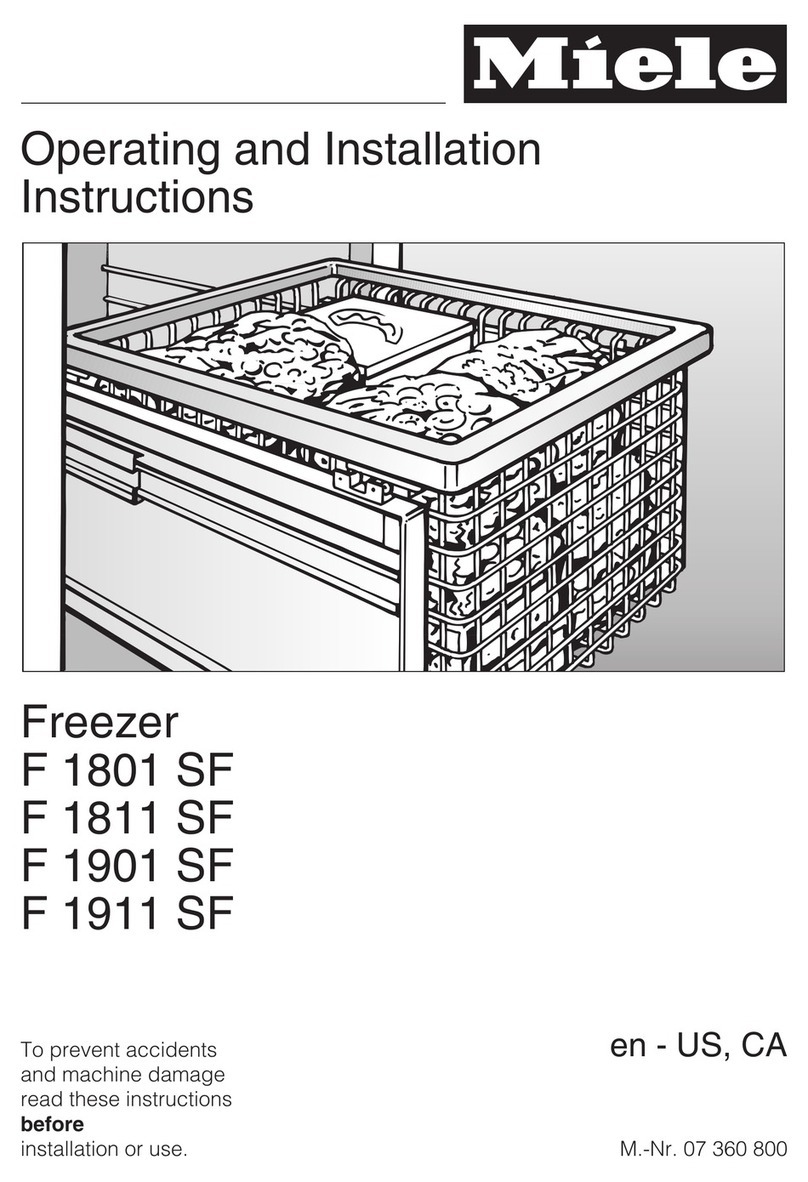
Miele
Miele F 1801 SF Operating and installation instructions

VESTEL
VESTEL KVC682ILGE user manual
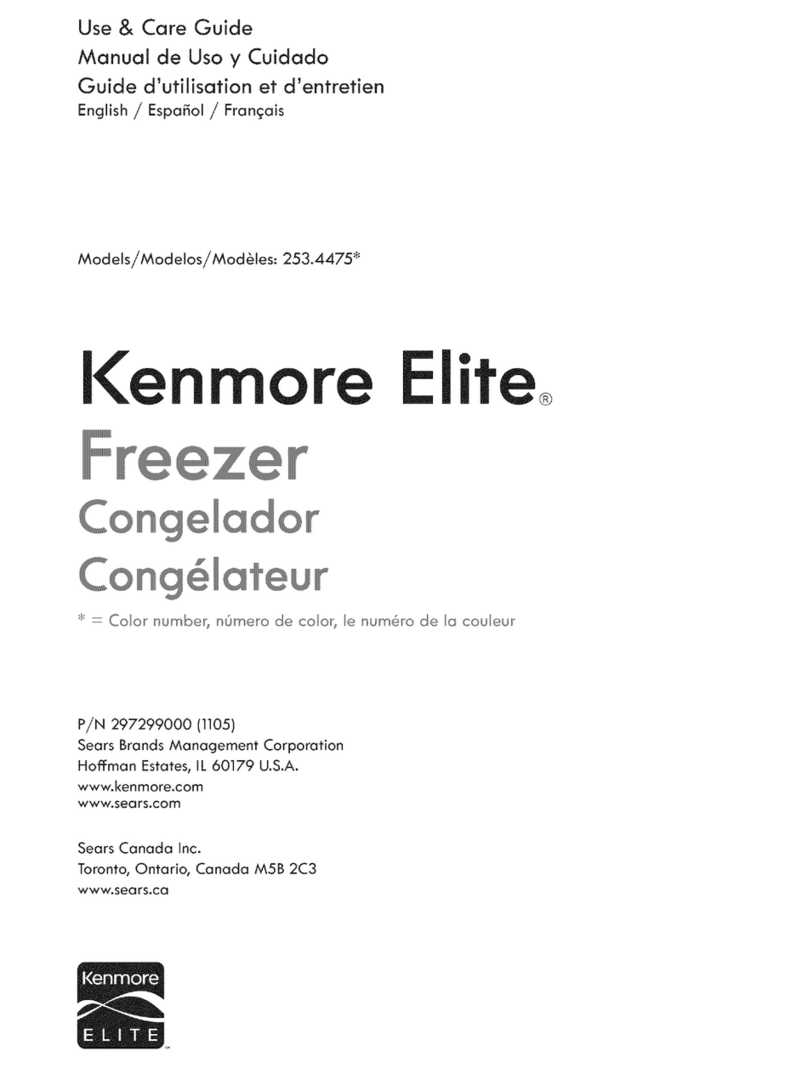
Kenmore
Kenmore ELITE 253.4475 Series Use & care guide
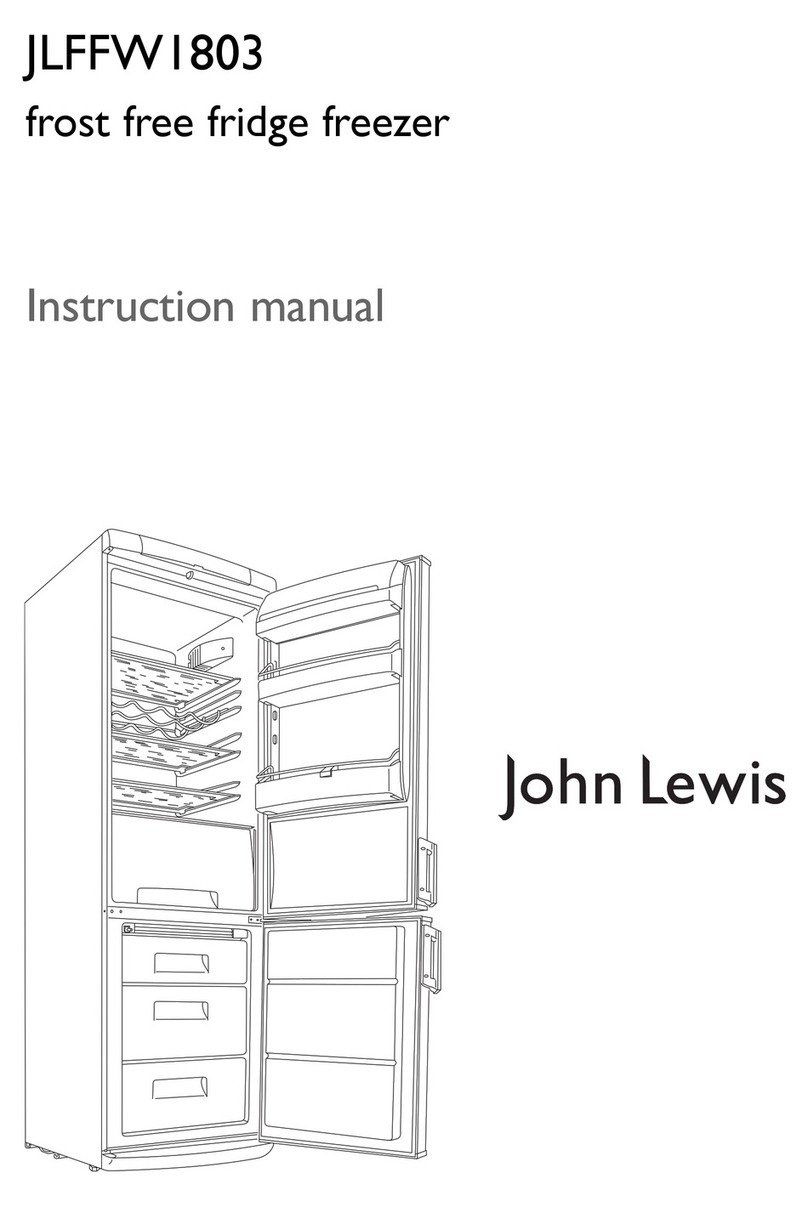
John Lewis
John Lewis JLFFW1803 instruction manual

